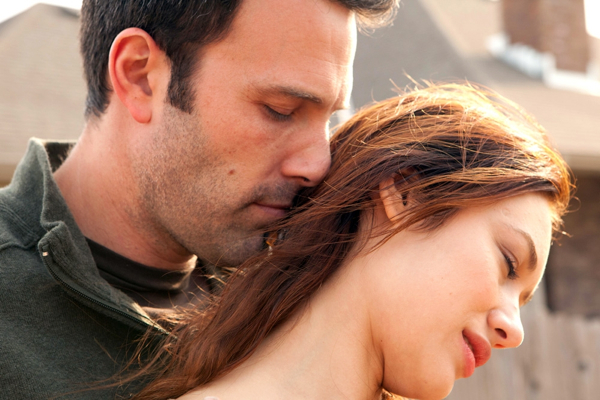Movie review by Greg Carlson
The mixed reviews that have followed the near inevitable accounts of film festival boos and cheers for Terrence Malick’s “To the Wonder” report that the prestige filmmaker has paddled even deeper into the sea of idiosyncratic cinematic storytelling marked by the obscurity and inscrutability of deliberately withheld information and violations of the artist-audience contract. Because of chronological proximity, “To the Wonder” will be compared to the “The Tree of Life” more than to Malick’s earlier movies, even with the presence of several of the auteur’s longstanding thematic interests and storytelling devices. It might be a stretch to define the plot of “To the Wonder” as a love triangle, seeing as Malick has no use for plot and that one side of the triangle is little more than a “Giant”-inspired interlude.
In close collaboration with cinematographer Emmanuel Lubezki, Malick continues to refine the visual sensibilities that include subjective, swooping and dancing camera arcs, and the almost non-stop continuity interruptions and jump cuts that stitch together the bits and pieces selected from miles of footage collected during the shoot. Additionally, Malick retains his trademark use of whispery, fragmented voiceover narration, which provides as much or more verbal communication than any truncated slivers of interactive dialogue. “To the Wonder” features zero in-depth, sustained conversations and many have remarked that you probably see more shots from behind Ben Affleck’s taciturn Neil as he looks at something than images of his face.
One of the reasons Venice Film Festival audiences chortled at Javier Bardem’s yearning Father Quintana almost certainly has to do with Malick’s unwillingness to deliver a character via the expectations of the classical Hollywood cinema. The miserable priest ministers to prisoners and parishioners, wealthy and poor. He speaks of Christ’s presence, but the holy man wrestles internally with struggles as traumatic and personal as those faced by Bergman’s Tomas Ericsson or Bresson’s cleric of Ambricourt. To be sure, however, “To the Wonder” is nowhere near as satisfying as “Winter Light” or “Diary of a Country Priest.”
Affleck and Bardem are bigger stars than Olga Kurylenko, but what constitutes point of view belongs to her displaced single mother Marina, a fragile young woman made all the more alien when she accepts Neil’s invitation to leave Europe for the monotonous McMansions and Sonic Drive-Ins dotting the otherwise vast and empty Oklahoma landscape. Malick is now in his late 60s, but the years seem to have sharpened his appetite for the visual appreciation of the unknowable feminine. One reading of the filmmaker’s construction of Marina finds the old master out of his depth, infantilizing and disabling his character via what might be described as exotic othering. Marina’s blank slate condition frustrates and confuses as she lurches from childlike playfulness to violent outbursts called forth by some imprecise mental anguish.
The distinctions between the stoic and action-averse Neil and Marina’s constant twirling, whirling, and spinning suggest that Malick holds to old-fashioned and outmoded conventions that gender male “madness” as a matter of melancholic, Hamlet-like intellect and female “madness” as the biologically and emotionally codified erotomania of Ophelia. In one scene, Neil and Marina visit the office of an OB/GYN who recommends the removal of Marina’s IUD following unspecified but implied cause for concern. Marina is also informed that a hysterectomy will not be necessary. What can we make of this or of anything else that we see when Malick conceals so much more than he illuminates?
